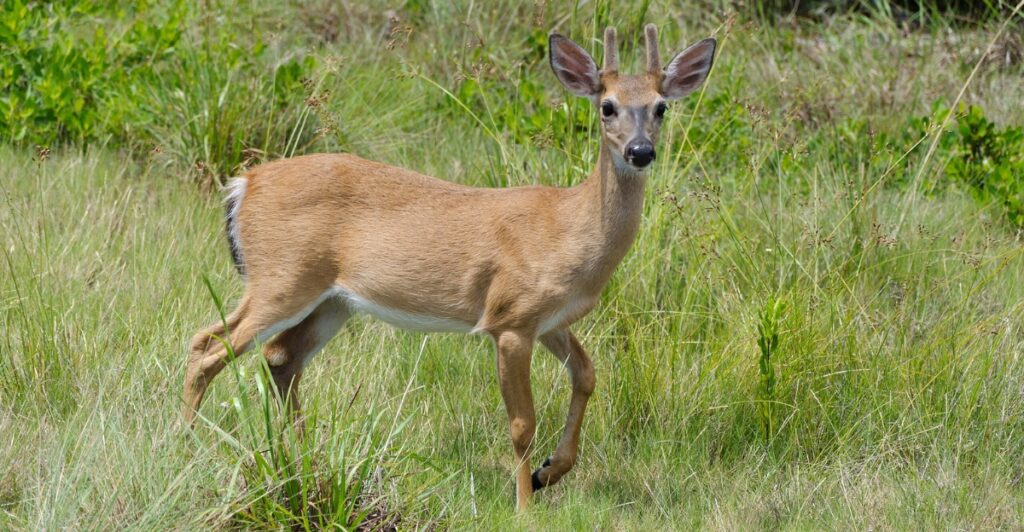
Nestled in the piney wetlands of the Florida Keys, Key deer have captivated residents and visitors with their small stature and gentle presence. These diminutive deer, a subspecies of the white-tailed deer, are found nowhere else on Earth. Yet, as sea levels rise and their habitat diminishes, these cherished creatures face a perilous future.
A Unique Species Under Threat
Key deer are the smallest subspecies of white-tailed deer, with adult bucks rarely standing taller than three feet at the shoulder. They weigh around 75 pounds—less than half the size of their mainland counterparts. This small size is likely an adaptation to their isolated island habitat, a phenomenon known as insular dwarfism.
These deer are well-adapted to the pine rockland and freshwater wetlands of the Florida Keys. Their diet includes native plants such as mangroves, berries, and grasses, though they occasionally venture into residential gardens to graze on ornamental plants. Their small size and gentle nature make them particularly endearing to the residents of Big Pine Key, where the majority of the population is found.

Despite their charm, Key deer have always been vulnerable. Their limited range makes them especially susceptible to environmental changes and human activity. Conservation efforts since the 1950s have kept their population stable, but new challenges, primarily driven by climate change, now jeopardize their survival.
A Success Story at Risk
Key deer were listed as endangered nearly six decades ago after hunting and poaching reduced their population to about 50 individuals. Through conservation, the population rebounded, peaking at around 1,000 in the 2010s. However, recent challenges, including a deadly parasite outbreak and Hurricane Irma in 2017, have taken a toll, leaving the herd at approximately 800 today.
Now, climate change threatens to undo decades of progress. Rising seas are inundating the low-lying islands that the deer inhabit, particularly their primary home, Big Pine Key. “They were always vulnerable,” says Chris Bergh of the Nature Conservancy, “but they’re much more vulnerable now.”

Shrinking Freshwater and Vegetation
Key deer depend on freshwater sources, many of which are disappearing as seawater intrudes into the limestone bedrock of the Florida Keys. The National Oceanic and Atmospheric Administration predicts sea levels in the Keys could rise by 1.5 to 7 feet by 2100. By the mid-century, as much as 84% of the island’s preferred deer habitat could be submerged.
Saltwater intrusion is also transforming the landscape. The Florida slash pines that dominate Big Pine Key are dying, replaced by salt-tolerant mangroves. While mangroves play a crucial role in coastal ecosystems and form part of the deer’s diet, they also depend on the pine rockland for further sustenance. “As the sea rises, that shrinks the amount of freshwater, palatable vegetation, and places for bearing their young,” Bergh explains.
Human Impact and Coexistence
The Key deer’s plight is further complicated by the human presence on Big Pine Key, home to about 4,500 residents. The deer often wander into neighborhoods, seeking food and water. Some residents welcome them with buckets of water and lush gardens, but others are less accommodating. To make things worse, deer venturing near roads often meet fatal ends. Despite strict speed limits and wildlife crossings, vehicles kill up to 120 deer annually, according to Save Our Key Deer chief scientist Jan Svejkovsky.

Development over the decades has also fragmented their habitat. While the National Key Deer Refuge protects more than 8,500 acres on Big Pine Key, ongoing construction encroaches on the deer’s remaining safe spaces. Park ranger Katy Hosokawa emphasizes the challenge: “The more houses we build, the fewer areas they have that are safe.”
Climate Change and the Future
Rising sea levels are not the only climate-related threat. Stronger hurricanes, fueled by warming oceans, bring storm surges that flood freshwater supplies and destroy habitats. Hurricane Irma, for instance, devastated the Florida Keys and significantly reduced the Key deer population.
Experts are exploring drastic measures to preserve the species. Relocation, though rarely attempted, could be an option. However, as Nova Silvy, a Texas A&M professor emeritus, notes, “If you take them any other place with deer, they’re going to interbreed and then you’ve lost the Key deer.” Zoos may become a last resort, but most conservations view this as an undesirable alternative.

A Call for Action
The Key deer’s fate mirrors the broader challenges faced by the Florida Keys, a chain of islands already grappling with rising seas and habitat loss. While efforts to protect these unique creatures continue, their future depends on addressing the root causes of climate change. For now, residents, conservationists, and policymakers must work together to preserve the Key deer’s habitat and legacy.
Resources:
- National Wildlife Federation: Key Deer
- CBS News: Climate change threatens habitat of Key Deer, other native species
- NASA Earth Observatory: The Changing Seas of the Florida Keys
Stay connected with us for more stories like this! Follow us to get the latest updates or hit the Follow button at the top of this article, and let us know what you think by leaving your feedback below. We’d love to hear from you!







